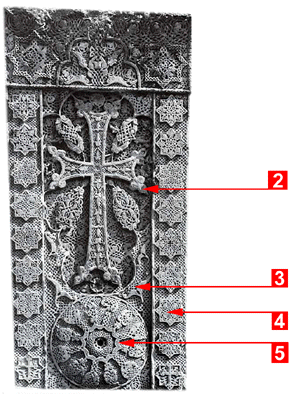1. The stones are made of either basalt or tuf, and intricate patterns were carved in the form of the cross, with embellishing patterns covering the spaces between.
2. Threes. The ends of each cross were first carved with simple ends. After the Armenian church rejected the decisions of the Council of Chalcedon at the synods of Dvin (502 Ad and 552-554 AD), Armenians placed greater emphasis on the divine, rather than the human, nature of Christ. This led to an avoidance of representations of the Passion, and to a preference for the sublimation inherent in the symbol of the cross, as opposed to explicit iconography. By the 9th century, as Armenia broke free from Arab domination, the symbolism of the Holy Trinity emerged, and crosses were shown with their points ending with three additional points, symbolizing the Father, son and the Holy Spirit. Many earlier Khachkars, which rested in single pedestals, were raised on top of a new foundation of three pedestals to conform to this new doctrine.
 3. The Tree of Life. At least as early
as the Metsamor Period, the symbolic form of the tree of Life
is found on Ancestral Armenian sacred design. As a symbol, the
tree was divided into two parts by the Urartian period, showing
two equal parts (yin-yang, or duality) curved around a central
form. In the Khachkar, the tree was carved at the base of the
cross, curving around the lower part of the cross
3. The Tree of Life. At least as early
as the Metsamor Period, the symbolic form of the tree of Life
is found on Ancestral Armenian sacred design. As a symbol, the
tree was divided into two parts by the Urartian period, showing
two equal parts (yin-yang, or duality) curved around a central
form. In the Khachkar, the tree was carved at the base of the
cross, curving around the lower part of the cross
4. Solar Disk. At first banished from religious design when Gregory the Illuminator began his holy crusade, by the 7th century the ancient Armenian symbol of the sun appeared in repeated patterns on churches and at the base of the cross. By the 9th century it became a required part of the overall design.
5. By the 9th century an Armenian form of the "Celtic knot" was developed, where lines in patterns have no beginning or an end, and numerous sacred number combinations can be found in each one.
6. At first glance looking like Celtic crosses, Armenian Khachkars are unique to themselves. Celtic Crosses are wing-crosses, while Armenian Khachkars are almost exclusively carved in bas or high relief on a single side of the stone.
7. The master carvers in Armenia were so adept that they turned solid stone into delicate pieces of lace.
8. A special technique was used to carve the intricate patterns, including using needles to inject water in the stone before carving it. There are no words to describe how stunning these monuments can be, and even more mind boggling is that in the republic alone, over 40,000 Khachkars have been counted--and no two are alike.